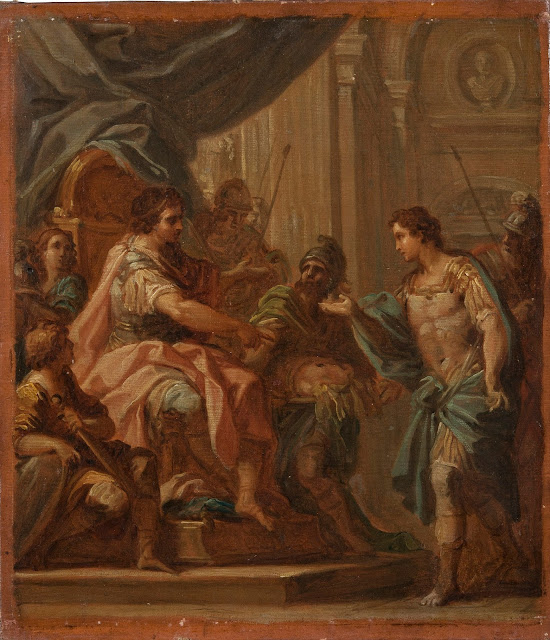 |
| Giandomenico Tiepolo Presentation in the Temple ca. 1760-70 oil on canvas Nationalmuseum, Stockholm |
 |
| Giuseppe Bazzani Esther and Ahasuerus before 1769 oil on canvas Nationalmuseum, Stockholm |
 |
| Michele Marieschi Staircase in Renaissance Palazzo before 1743 oil on canvas Nationalmuseum, Stockholm |
 |
| Michele Marieschi Courtyard in Renaissance Palazzo before 1743 oil on canvas Nationalmuseum, Stockholm |
"The proprietors of palaces in the 18th century were living by a standard, and the same one occurred throughout civilized Europe: it can be said that all of Europe was emulating what had been standard and commonplace in Italy for over a century. This emulation occurred in two ways: first through what may be called the filter of Versailles (and French art was not, as art, the nationalist matter its 19th century historians made of it) and secondly, as in England, by a more direct experience. It was possible to build a grandchild of Palazzo Barberini (with the proper rearrangements due to developments in Paris or elsewhere) whether in St. Petersburg or on the Broads of Norfolk, and to behave within it very much as the Barberinis did in Rome. The prestige, if not the power, of Italy and Italian art, was still in the 18th century extremely high, and what was seen in the Grand Tour was never forgotten. And one had seen still incomparable collections in incomparable number. The Italians sold continually throughout the century and yet in Rome in 1790 there were over a dozen palaces (not including the papal collections) which together gave a concentration of prime paintings not yet matched in Dresden, Madrid, Paris or St. Petersburg, and of which some were each still superior to the collections of other monarchs and potentates of Europe outside of Italy. Naturally the contents of these palaces, and of many others in Italy, were thought worthy of wholesale and often uncritical emulation. Remember, too, that although the kings of France had purchased antique sculptures for over two centuries, a single princely family like the Borghese had a better and much larger collection: that the great collection of statues of the king of Spain was a private collection made and bought in Rome; that one of the best collections of antiquities in Germany was bought from a Roman cardinal who simply went on to furnish Villa Albani with a yet greater collection."
– Anthony M. Clark, from The Development of the Collections and Museums of 18th Century Rome, published in Art Journal (Winter 1966-67)
 |
| Pietro Rotari Girl looking through Telescope before 1762 oil on canvas Nationalmuseum, Stockholm |
 |
| Pietro Rotari Girl with Needlework before 1762 oil on canvas Nationalmuseum, Stockholm |
 |
| Alessandro Magnasco Concert amidst Ruins before 1749 oil on canvas Nationalmuseum, Stockholm |
 |
| follower of Carlo Cignani Apollo ca. 1720 oil on canvas Nationalmuseum, Stockholm |
 |
| Francesco Trevisani Portrait of a Nun before 1746 oil on canvas Nationalmuseum, Stockholm |
 |
| workshop of Francesco Trevisani Portrait of Cardinal Pietro Ottoboni before 1746 oil on canvas Nationalmuseum, Stockholm |
"In the 18th century there was almost no domestic or learned establishment in Rome which was not in a sense a museum, whether the palaces of the Pope, of the aristocrats, of the foreign ambassadors, or of the learned and their colleges and academies. Small so-called museums were attached even to some of the minor and a number of the major monastic establishments, or to the larger libraries. It was especially rare for a great noble not to be particularly wealthy in art, and although there was a considerable loss by sales from these inherited sources throughout the century, this fact has been exaggerated through being supported by the more available of the documents, by the sensational nature of the sales, and, perhaps, to soften the blow of the vast losses at the end of the century. The great and minor holdings of art in Rome were well-known through travel and guide books, reputation, and the efforts of the local cicerone; entrance to them was in almost all cases customary and easy, far easier than today."
– Anthony M. Clark, from The Development of the Collections and Museums of 18th Century Rome, published in Art Journal (Winter 1966-67)
 |
| attributed to Marcello Bacciarelli Stanislaus Poniatowski, King of Poland, in coronation robes ca. 1764 oil on canvas Nationalmuseum, Stockholm |
 |
| Sebastiano Conca Study for David and Saul before 1764 oil on canvas Nationalmuseum, Stockholm |
 |
| Lorenzo Gramiccia The Virgin mourning at the Tomb 1764 oil on canvas Nationalmuseum, Stockholm |
 |
| Andrea Locatelli Landscape with Soldiers and Peasants before 1741 oil on canvas Nationalmuseum, Stockholm |